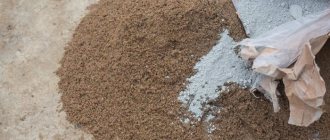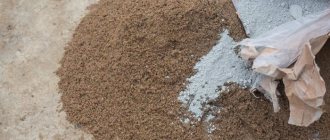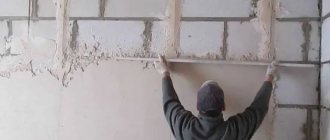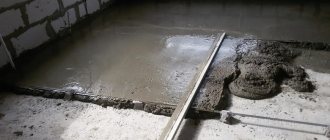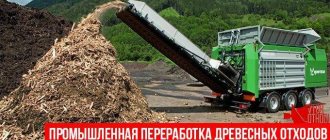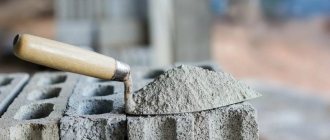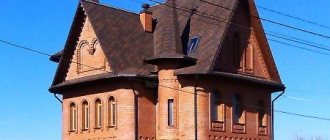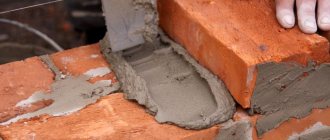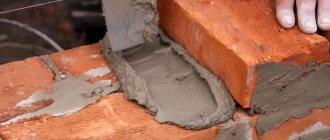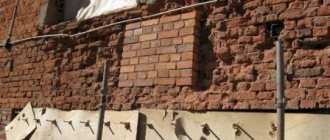How is cement mortar prepared?
Many people mistakenly believe that components are added to water. This method does not allow you to stir the mixture evenly. Lumps form in the solution and sand “sticks” to them.
Proper mixing requires the following procedure:
- The sand is poured in first. It must be sifted first. It is allowed to use a mesh with large cells. The main thing is to remove shells, organic particles, clay pieces, and pebbles. They cling to walls, leaving furrows behind.
- The cement is poured second. Both components are dry mixed with each other. This imposes certain requirements on the sand, which must be dry, which allows for a thorough connection of the bulk components.
- Water is poured into the dry component of the mortar for plastering walls. You cannot pour all the liquid at once. First pour out 2/3 of it. Mix everything thoroughly. The remaining liquid is poured out when it becomes unbearably difficult to mix the components.
If you follow this sequence of actions, you will get a homogeneous mixture without any lumps. It will fit perfectly on the walls and not leave any grooves.
Application technology
See also
Vertical siding: what is the difference, pros and cons, where is it used?
Not everyone knows how to properly plaster with cement plaster.
The technology includes 3 stages:
- splash;
- priming;
- covering
Each stage has its own composition of the solution.
- Spray
. This is the first stage. Here you need to apply a layer of mortar using a ladle. Then leveling occurs. A rule or a grater will come in handy. The layer that is applied when spraying depends on the surface material. For wood this is up to 10 mm, for brick up to 7 mm, and for concrete about 4-5 mm. At the spraying stage, a reinforcing mesh is also attached. Use a solution of medium consistency; - Soil
. It is also a primer or base layer. A thicker mass is required. Apply with a falcon or trowel. Excess can be removed after 30 minutes to allow strength to form. The recesses and voids are filled with the same solution, after which they are leveled using the rule. Layer thickness up to 5 mm; - Having covered
. This is the finishing layer. A fairly thin solution with a thickness of 4 mm is used. Before this, the base layer should be slightly moistened. When the mixture adheres to the wall, grouting is done in a circular motion. Here you will need a grater.
Now you know how standard work is carried out using a cement-sand mixture for plastering walls.
Lighthouses
There is also DSP plaster for lighthouses. Quite a common technology.
Lighthouses are metal profiles that have functional stiffening ribs. Beacons are mounted on the walls before plastering begins. Fastening is carried out with self-tapping screws or quickly hardening solutions.
The slats should be leveled using a level and a plumb line.
Between the beacons they maintain a step in the range of 1-1.5 m. But from the edge of the wall and the corner you need to make an indent of no more than 30-50 cm.
Due to the beacon, the procedure for applying the composition is simplified and also accelerated. You can level the plane easier and faster. Between the beacons the solution is thrown from bottom to top. The rule is to remove excess, leaning on the ribs of the lighthouse.
If the beacons are not galvanized or made of stainless steel, they should be removed before the solution dries completely. The voids are filled with mortar and then grouted.
Important nuances
Never pour all the liquid into dry ingredients at once. If you completely pour water into cement and sand, the mass will turn out to be too liquid, which will sharply reduce the quality of the mix. To prevent such a mistake, first use a small part, and then add the rest. It is recommended to sift sand using a mesh with different cell sizes. Bulk material for mixing the mortar used for primer layers of plaster is sifted through cells measuring 2-3 mm, and for covering layers - 1 mm.
What brand of cement should I choose for the mortar?
It is determined by the degree of compression of both frozen and completely dried mortar for plastering walls. The composition dries completely within 28 days. The ratio of binder and fillers, which can be perlite, fine slag, sawdust, polystyrene granules, etc. An incorrectly selected brand of cement provokes destruction of the plaster. It begins to peel, crack, and crumble due to shrinkage. This kind of plaster cannot be left. It will have to be updated. This will entail additional expenses.
Criterias of choice
There is no universal brand for mixing plaster. The choice is determined by what kind of work is planned to be performed. Plaster can be light, external, waterproof, internal, heat-insulating. The solution is used for spraying, priming, and covering. The main criterion is the composition of the base.
Features of some brands of cement
Characteristics of various grades of cement:
- M50 . Lightweight. This brand is suitable exclusively for grouting. It is characterized by low strength and minimal shrinkage. This cement is perfect for finishing plaster.
- M100 . It has a dense composition. This brand is suitable for finishing indoor walls. It is distinguished by the presence of lime in the mixture. It is used not only for plastering, but also for leveling the surface of walls.
- M150 . It is a universal composition for plastering and masonry compositions, arranging screeds, and carrying out repairs. Reasonable cost and higher strength allow you to save on preparing the solution.
- M200 . It is produced for a specific purpose, including for plastering walls. The main feature is increased strength.
- M300 . Not suitable for plastering wall surfaces. The brand is most often used as a component of masonry mortars.
- Grades M400 and M500 have a high price, but have increased strength, so they are often used in the preparation of plaster.
Main components
In construction and renovation, plastering walls with cement-sand mortar is widely used. One of the options for plaster over insulation, by the way.
Since this is a cement-sand mixture for plaster, it is already clear that the key components of the composition are cement, as well as sand.
It is important to note that the composition of cement plaster for interior work, as well as for exterior decoration, may differ. But the main ingredients are always the same.
Cement acts as a binder. The component is obtained by roasting and crushing mountain limestone, as well as silicate clay. Mixing with water, the powder turns into a plastic mass. When dry it becomes monolithic. Therefore, leveling walls with cement mortar allows you to obtain coatings that are not inferior in terms of strength to stone.
Cement or cement clinker has a marking that depends on its ability to withstand loads. The composition of cement plaster for interior work usually includes powder grade M100-M250. If you need to finish the facade, plinth or make a blind area, then take M300-M500.
Sand, also known as fine quartz filler, can be river, quarry, or sea. It is important that the sand-cement mixture for plaster does not contain clay residues, biological or mineral impurities. To do this, the sand should be sifted and washed. Depending on the functions and tasks of the central sand mill, the appropriate sand fraction is selected.
How to correctly determine the brand of cement for plastering wall surfaces?
Focusing solely on the purpose and properties of the brand is not the most correct approach. The choice actually depends on many factors. Experienced craftsmen test the finished cube of completely set mortar on a special stand. Craftsmen prepare plaster solutions taking into account the brand of cement.
For the M400 brand they take four buckets of sand, and for the M500 - five. Compliance with this simple rule allows you to create high-quality plaster mortar. Increasing or decreasing the amount of bulk components allows you to change the density and strength of the plaster.
Technical parameters of finishing mortar for walls
The plaster mixture has several important characteristics:
- Strength for mortars when 3 buckets of sand are placed on M500 cement.
- Thermal conductivity of heavy compositions and dense plaster with a decrease in the proportion of the bulk component.
- Water resistance for dense solutions. The lungs can be modified by adding substances that increase the mixture's resistance to water. The most commonly used materials are ceresite, liquid glass, and polymer resins.
- Frost resistance, characteristic of light varieties of plasters, when M500 grade cement is taken to prepare the mortar and mixed with 6 buckets of sand or less. These mixtures are used for finishing walls only indoors. External plastering of walls is not carried out in this way.
The technical properties of the mixtures are directly determined by the density of the solution. Lightweight ones are ideal for plastering walls indoors, and heavy ones, which are highly resistant to frost and moisture, are ideal for plastering walls outside.
Types of cement-based mixtures that are included in the composition
For plastering, many compositions are used, but most often they use a solution made on the basis of cement and sand, cement, and lime. Below we will look at their main properties.
Cement-sand
We can say about cement-sand plaster that it is a very reliable and inexpensive wall covering. During construction, situations may arise when it becomes indispensable. The properties and required parameters are defined in GOST 5802-86, the necessary data is obtained as a result of tests carried out at the factory.
To perform plastering work, the following grades of composition M25, M50 and M100 are used.
- The ratio of sand and cement in the M25 grade is 1/13.5 when using M500 cement, for M400 cement 1/12.5 and for the M300 grade, the ratio is
- For the M50 mixture, the proportions will be: 1/7 with sand - when using M500 cement, 1/6 - for M400, 1/5 - for M300.
- For the M100 mixture, the ratio of components will be: for M500 cement – 1/4.5; for cement M400 – 1/3.5; for M300 – 1/2.5 with sand.
The higher the grade of the composition, the greater the strength, but it makes no sense to use it everywhere, anywhere.
We can say about cement-sand plaster that it is a very reliable and inexpensive wall covering.
Cement-lime
Initially, you need to understand the advantages of these compounds:
- Plastic. Such compositions are easy to apply and resistant to cracking. The cement mixture is prone to cracking, but adding lime eliminates this property.
- Adhesion. The solution fits well on surfaces made of concrete, brick, wood, etc.
- Strength. If a standard mortar easily gets damaged even with minor mechanical stress, then the combination of cement and lime gives the plaster strength and reliability. And ensures a product lifespan of up to 10 years.
- Resistance to biological damage. In particular, to mold. This allows the solution to be used in rooms with high humidity.
Long-term preservation of plasticity, the applied solution retains it for 2-3 hours, this allows you not to rush when doing the work.
Tactical and technical characteristics of the solution:
- Frost resistance - 50 cycles;
- Laying temperature +5 +30 degrees;
- Adhesion 0.3 MPa;
- Compressive strength 3 – 6 MPa;
- For 1 sq.m. consumes up to 18 kg.
Such compositions are easy to apply and resistant to cracking.
Consumption of cement-sand mortar when plastering walls
Calculating the amount of mixture needed to plaster one square meter of wall is quite simple. It is enough to multiply the thickness of the layer and the total working surface area. The minimum thickness of the plaster layer in the protruding part of the beacons is 6 mm, and the maximum, depending on the curvature, can reach several centimeters. The slope is also taken into account. All saggings are measured. They add up. This amount is divided by the number of measurements taken. The average is multiplied by the wall area.
Final work
The process of leveling the walls is completed by removing the beacons and grouting the plaster.
At the beginning of this century, there was no consolidated point of view among professional builders regarding metal profiles remaining in plaster. Some beacons were removed, others were left. It is now considered correct to remove metal from the plaster layer. Traces left on the wall after the operation are sealed with mortar or putty.
How to quickly and correctly remove beacons can be found in the article “Do I need to remove beacons after plastering walls?”
Grouting is done only before painting. The technique is simple: a home craftsman pours the solution onto the wall using a ladle or bowl from a kitchen set. The wet spot (this is what you should get if the mixture is prepared correctly) is processed with a grater in a circular motion or in a smooth motion (up and down). All-round grouting is coarser and is performed mainly on medium-quality plaster.
To perform the operation you need a grater. It is pressed flat against the plaster and with hand movements counterclockwise, the tubercles are cut off with the edge of the tool, while simultaneously filling the depressions with the solution moved under the grater. The pressure on the grater needs to be adjusted. Where there is a bulge, press harder, where there is a depression, press less. The solution that accumulates on the edge of the grater is periodically removed. It can be put into a mixing container or filled into existing sinks.
If after circular movements there are barely noticeable traces, they are removed with sweeping movements. To do this, a well-cleaned trowel is pressed against the wall and the grouting process is completed with up-and-down strokes.
